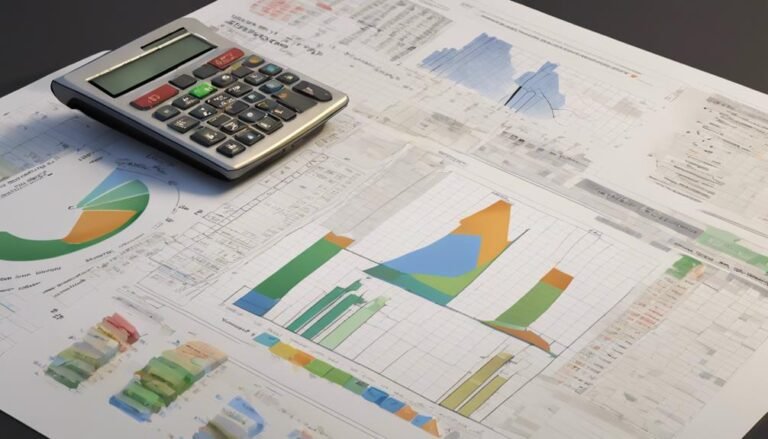Investment Accounting: Equity and Debt Securities
Understanding the classification, valuation, and accounting of equity and debt securities is crucial in investment accounting. By knowing how these securities are categorized and valued, you can make informed financial decisions. The method used for valuing and accounting for these securities will impact your financial statements. If you grasp these concepts, you will have a solid foundation for navigating the world of investment accounting.
Key Takeaways
- Classification of securities includes equity and debt securities with different risk profiles.
- Valuation methods like market-based and income-based approaches determine fair value.
- Proper accounting ensures accurate representation in financial statements for effective decision-making.
- Fair value reflects current market prices, while amortized cost is based on historical costs.
- Understanding fair value vs. amortized cost impacts financial statement transparency and decision-making.
Importance of Investment Accounting
Understanding the significance of investment accounting is essential for making informed financial decisions and accurately evaluating the performance of your investments. The importance of investment accounting lies in providing a framework to track and assess the financial health of your investments. By utilizing various analysis techniques, such as ratio analysis and trend analysis, you can gain insights into the profitability and risk associated with your investment portfolio.
Analysis techniques play a vital role in investment accounting as they help in interpreting financial data to make strategic decisions. Through ratio analysis, you can compare key financial indicators to industry benchmarks, enabling you to gauge the efficiency and profitability of your investments. Trend analysis allows you to identify patterns and predict future performance based on historical data, aiding in formulating investment strategies.
Classification of Equity Securities
To better comprehend the landscape of investment accounting, it's essential to grasp the classification of equity securities within the domain of financial portfolios. Equity securities represent ownership interests in companies and are classified into three categories: held-to-maturity, available-for-sale, and trading securities. Understanding the classification of equity securities is vital for investors to assess the risk and return characteristics of their investment portfolios.
Market trends play a significant role in determining the classification of equity securities. Changes in market conditions can impact the valuation of these securities and influence their classification. For example, if there's a sudden shift in market trends leading to increased volatility, securities that were previously classified as held-to-maturity may need to be reclassified as trading securities to reflect the new market realities accurately.
Being aware of market trends and the classification of equity securities is essential for investors to make informed decisions about their investment strategies. By closely monitoring market trends and understanding the classification criteria, investors can adapt their portfolios to changing market conditions and optimize their investment returns.
Valuation Methods for Equity Securities
When valuing equity securities, investors often use a combination of market-based and income-based methods to determine the fair value of these financial assets. The market approach involves looking at the current market price of similar securities to estimate the value of the ones being evaluated. This method is straightforward and relies on the principle that similar assets should have similar market values.
On the other hand, the income approach focuses on the potential income that the equity security can generate. This method considers factors like dividends, earnings, and cash flows to assess the present value of the investment based on its future income-generating potential. By using valuation models such as discounted cash flow analysis or price-to-earnings ratios, investors can make informed decisions about the worth of equity securities.
In practice, investors often use a combination of these approaches to gain a holistic understanding of the fair value of their equity securities. By considering both the market and income perspectives, investors can make more informed decisions regarding their investment portfolios.
Characteristics of Debt Securities
When analyzing debt securities, it's vital to take into account various factors such as:
- The types of debt
- Associated risks and returns
- The methods used for valuation
Understanding the distinctions between different types of debt instruments can help you assess their characteristics and make well-informed investment decisions.
Evaluating risk and return profiles alongside valuation techniques provides a thorough view of the potential outcomes of holding debt securities.
Types of Debt
Debt securities represent a form of investment where an entity lends money to another entity, typically in the form of bonds or notes, with the expectation of receiving interest payments and the return of the principal amount at maturity.
When it comes to types of debt securities, they can vary based on their characteristics and terms. Below is a table outlining some common types of debt securities:
| Type of Debt Security | Description | Example |
|---|---|---|
| Corporate Bonds | Issued by corporations to raise capital. | Apple issuing bonds to fund projects. |
| Government Bonds | Issued by governments to finance operations. | U.S. Treasury bonds providing a safe investment. |
| Municipal Bonds | Issued by state and local governments. | Funding for city infrastructure projects. |
Understanding the different types of debt securities is essential for investors looking to diversify their portfolios. Whether it's through corporate bonds, government bonds, or municipal bonds, each type offers varying levels of risk and return potential. Bond issuance is a common way for entities to raise capital while providing investors with a fixed income stream.
Risk and Return
Understanding the risk and return characteristics of debt securities is essential for investors seeking to make informed investment decisions. When it comes to risk assessment and portfolio management, debt securities offer unique features that investors should consider:
- Interest Rate Risk: Debt securities are subject to interest rate fluctuations, which can impact their market value. Understanding how changes in interest rates affect the value of debt securities is vital for managing risk.
- Credit Risk: This refers to the risk of the issuer defaulting on payments. Investors need to assess the creditworthiness of the issuer to mitigate this risk effectively.
- Liquidity Risk: Debt securities may face liquidity issues, making it challenging to sell them at a fair price. Investors should evaluate the liquidity of debt securities in their portfolio for effective portfolio management.
- Reinvestment Risk: When debt securities generate cash flows, investors face the risk of having to reinvest these funds at lower interest rates. Being aware of reinvestment risk helps investors make strategic decisions regarding their portfolio.
Valuation Methods
To properly evaluate debt securities, you must employ reliable valuation methods that consider their unique characteristics. Two common approaches used in valuing debt securities are the market approach and the income approach. The market approach involves looking at the prices of similar securities in the market to determine the value of the debt security in question. On the other hand, the income approach focuses on the expected future cash flows generated by the debt security. This approach often involves using discounted cash flows to calculate the present value of these future cash flows.
When using the income approach, investors typically consider factors such as the interest rate environment, credit quality of the issuer, and the maturity date of the debt security. Additionally, comparable companies in the same industry can provide valuable insights into how similar debt securities are valued in the market. By carefully applying these valuation methods, investors can make informed decisions when buying or selling debt securities.
Accounting for Debt Securities
When accounting for debt securities, it's essential to contemplate their classification and measurement. These two aspects play a significant role in determining how these securities are recorded in financial statements.
Understanding the classification and measurement of debt securities is fundamental for accurate and transparent financial reporting.
Classification of Securities
You frequently categorize debt securities based on their characteristics and intent of holding in investment accounting. When it comes to managing your investment portfolio, understanding the classification of debt securities is vital for making informed decisions.
- Investment Strategies: Different debt securities align with various investment strategies. Whether you're aiming for long-term growth or short-term gains, the classification of these securities can help you tailor your investment approach accordingly.
- Market Trends: Keeping an eye on market trends is essential when categorizing debt securities. By analyzing market conditions, you can determine which types of debt securities are more likely to perform well in the current economic environment.
- Portfolio Diversification: Categorizing debt securities based on their risk profiles allows you to diversify your portfolio effectively. Balancing high-risk and low-risk securities can help mitigate potential losses.
- Risk Management: Understanding the classification of debt securities aids in risk management. By categorizing securities based on their credit ratings and maturity dates, you can assess and control the level of risk in your investment portfolio.
Measurement of Securities
Understanding the valuation methods for debt securities is essential in investment accounting for accurately reflecting their market value in financial statements. When valuing debt securities, two primary approaches are commonly used: the market approach and the income approach. The market approach involves determining the fair value of the security by considering the prices of similar securities in the market. On the other hand, the income approach calculates the present value of the expected cash flows from the debt security, taking into account factors such as interest rates and risk.
| Valuation Method | Description |
|---|---|
| Market Approach | Considers market prices of similar securities to determine fair value. |
| Income Approach | Calculates present value of expected cash flows from the debt security. |
Fair Value Vs. Amortized Cost
To effectively differentiate between fair value and amortized cost in investment accounting, it's essential to understand their distinct characteristics and implications on financial reporting. Fair value analysis focuses on current market prices, providing a more accurate reflection of an asset's true value. On the other hand, amortized cost is based on historical cost and the gradual recognition of interest income or expenses. Here are some key points to bear in mind:
- Fair value analysis allows for more frequent adjustments to reflect market changes.
- Historical cost comparison can sometimes result in assets being undervalued or overvalued on the balance sheet.
- Amortized cost is more suitable for long-term investments where holding until maturity is the intention.
- Fair value accounting can lead to increased volatility in financial statements compared to the more stable nature of amortized cost.
Understanding the differences between fair value and amortized cost is essential for making informed decisions regarding investment valuation and financial reporting.
Implications on Financial Statements
The analysis of fair value and amortized cost in investment accounting greatly influences the presentation of financial statements. When determining the impact on financial statements, it is essential to take into account the reporting requirements and disclosures associated with each method.
| Fair Value | Amortized Cost |
|---|---|
| Reflects current market value | Recorded at historical cost |
| Subject to fluctuations in value | Generally stable valuation |
| Requires frequent revaluation | Minimal impact from market changes |
| Reflects potential gains or losses | Limited to impairment adjustments |
| Provides transparency on asset values | May not fully represent market conditions |
Understanding these differences is vital for accurate financial statement analysis. Fair value measurements can lead to more volatile financial statements, while amortized cost generally provides a more stable representation. Reporting requirements dictate the method to be used, and disclosures are necessary to inform users of the financial statements about the chosen approach and its implications. Striking a balance between these methods is key to presenting a clear and informative financial picture.
Regulatory Considerations
Considering the implications on financial statements, it's imperative to address the regulatory considerations surrounding investment accounting methods, particularly in the domain of equity and debt securities. When navigating the domain of regulatory compliance in investment accounting, there are key audit considerations to keep in mind:
- Documentation Requirements: Guarantee that all transactions related to equity and debt securities are meticulously documented to meet regulatory standards.
- Fair Value Assessment: Regularly assess the fair value of securities to comply with accounting guidelines and provide transparency to stakeholders.
- Disclosure Obligations: Fulfill disclosure requirements to provide investors with a detailed view of the organization's investment portfolio.
- Internal Controls: Establish robust internal controls to safeguard assets and ensure accuracy in financial reporting, thereby facilitating a smoother audit process.
Conclusion
To sum up, investment accounting plays a vital role in accurately reflecting the value of equity and debt securities in financial statements.
Did you know that according to a study by Deloitte, over 70% of companies globally use fair value measurements for their financial instruments?
This statistic highlights the widespread adoption of fair value accounting in the investment industry, emphasizing the importance of transparency and accuracy in reporting financial information.








